Help More Clients With Less Time & Tech
Get a steady flow of new clients and keep them coming back for more with all the tools you need to grow and succeed with ease online & offline. World-class training & support means you're never alone or left wondering what to do next. Live your dreams like thousands of other coaches, course creators, consultants, online business owners, and network marketers are doing with AttractWell since 2017.
Start For $1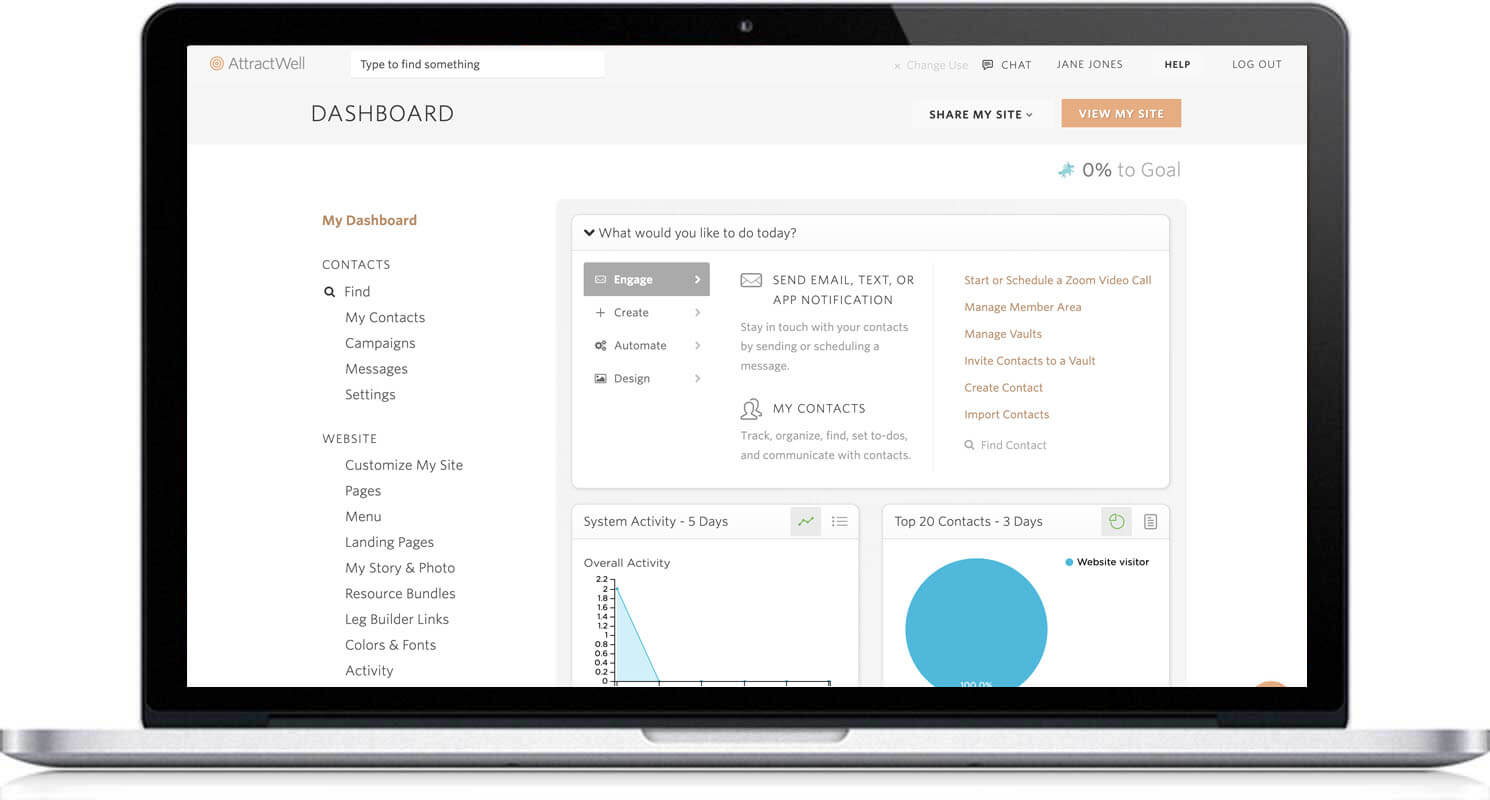
Everything you need, in one place.
Contact Manager & CRM Website & Funnels Online & Offline Events Courses & Private Communities Email & Texting Zoom Lead Generation Payments An App For You & Your Clients Automations Membership Sites Video Upload & Hosting AI Course Creator & Writer Integrations with Zapier Optional Unlimited Courses E-Commerce Store and so much more Plus, World Class Personalized Support & Free Live Training. ▶ Demo for coaches ▶ Demo for direct sellers Get a live demo



Need Leads?

Double your leads and high ticket clients without spending a fortune on complicated tech using this one-page strategy + training.
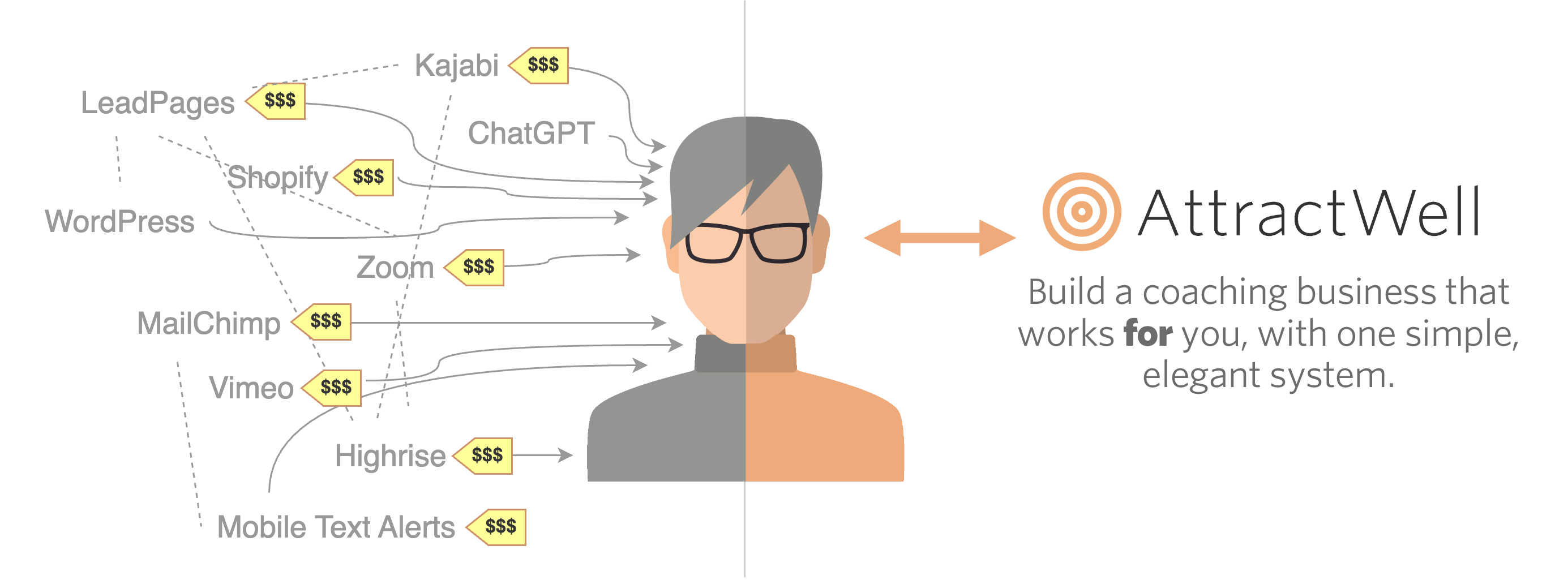
What AttractWell's Customers Say

Before AttractWell, I was throwing hundreds of dollars down the drain each month for programs and systems that were meant to create more ease in my business. I only found they created more challenges and headaches. AttractWell resolved every single issue I was facing! Their simple and efficient platform provides everything I need for my business in ONE place. I no longer have to juggle multiple platforms to reach, attract, teach, and connect with my clients. My website, along with the backend features, provide me with every single system I need to serve my clients. Do yourself a favor and stop thinking it has to be so hard and expensive. It doesn't! AttractWell is your answer!!

Amanda D
Health & Wellness Coach

Aaron Krall
Business Coach

Marc Mawhinney
Business Coach
Attract Your Ideal Clients
Attract your ideal clients with your personal brand to keep the leads flowing in.
Grow your prospect and customer list with your own lead capture pages, or build your marketing website.
Offer free or paid downloads or programs right from any page on your site, and let
AttractWell follow up automatically over time with email and text campaigns.
Engage and inform your visitors with AttractWell's ad-free video upload and hosting.
Connect your domain name to deliver a fully-branded experience for your visitors.
Publish blog posts to attract search engine visitors looking for what you offer.
Already have a marketing website that's working great for you? No problem.
AttractWell works great alongside your existing site.
Use the AI Writer tool to create content for your site in minutes, not hours.
Automatically summarize your blog posts, create social media posts, and more.
Replaces








“I created a subscription funnel in AttractWell and have had 10 new people come to me this week. It is amazing!”
Mari H - Health Coach

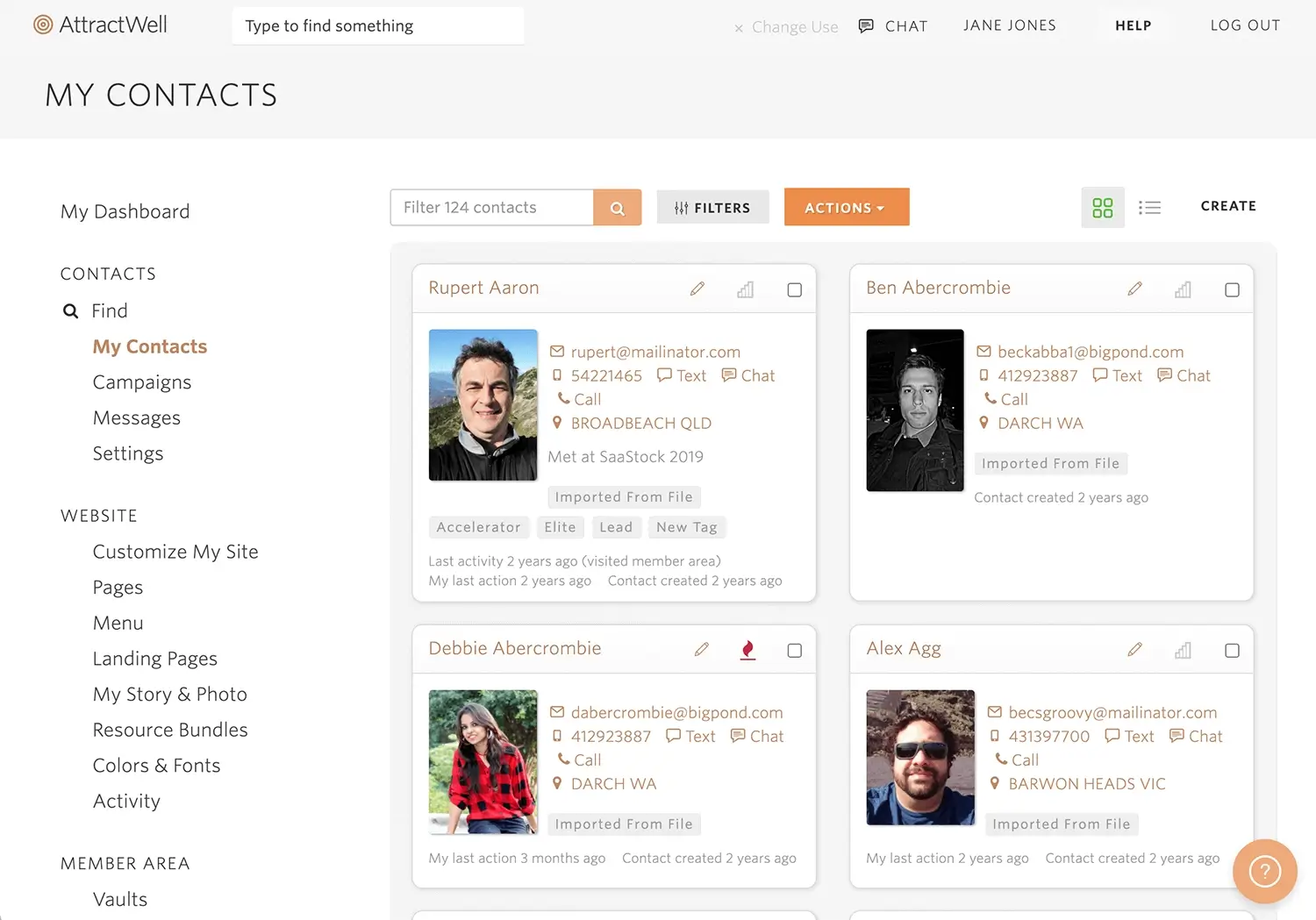
Get Your Clients Better Results
Don't forget to follow through ever again!
Use your contact manager to organize your contacts, personalize your email & text marketing
and send to your lists,
set reminders and to-do items for specific clients, and give them the
best experience possible, whether you have 1 client or thousands.
Use automations for a seamless, hassle-free client journey and know when
it's the right time for you to apply a personal touch.
Automatically add to-do tasks for yourself when people complete key steps
so you can reach out personally at the right times to delight your clients
and keep them coming back.
Replaces




“Before AttractWell, I was paying an insane amount of money for an expensive website that did not have a CRM. My assistant and I have established our own daily CRM practices, published email campaigns, sales pages, and metrics. Everything is streamlined now and in one place.”
Becky C - Real Estate & Life Coach
Sell Courses, Programs, & Memberships
Sell and deliver your courses and programs in your own branded-to-you member area, complete with a phone
and tablet app that both you and your clients can use.
Build a leveraged, automated system
for both your pre-recorded material and group coaching programs to free up your day.
Get your people off social groups
and into your private member area with your resource pages and
vibrant community discussion rooms, and transform their lives with
your online classes.
Create a course in minutes with the AI Course Creator. Let it create the course outline for you,
and then add your finishing touches.
Connect your Stripe account and offer one-time, payment plan, or recurring payment access to your vaults to create revenue
on your own terms, or offer free vaults to attract leads. Accept Afterpay/Clearpay and Klarna, along with wallets
like Google Pay and Apple Pay, and other popular payment methods like Bancontact, iDeal, and more.
See who finishes classes, require and approve homework, unlock lessons over time,
add tasks to your to-do list when people complete key steps, automatically send emails
and texts when classes are completed, and more. Add videos to your courses with the built-in ad-free video hosting and upload.
Looking for comparisons?
Compare AttractWell to Kajabi,
Compare AttractWell to New Zenler,
or
Compare AttractWell to Teachable.
Replaces







“I've got more done in one week on AttractWell than I did in three months with Kajabi. I also have to say that to support that you all have given me in just one week has been stellar!”
Coach Mark R - Life Transition Coach

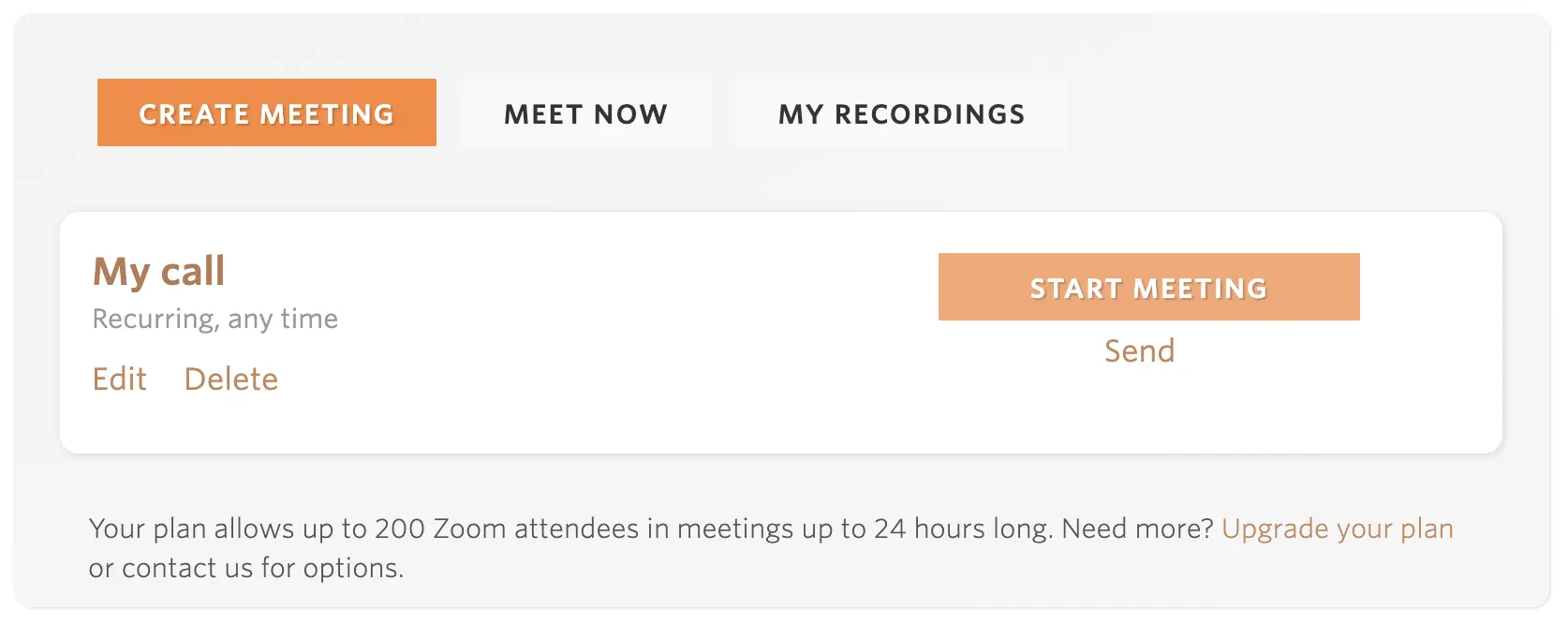
Meet Face-To-Face Online
Connect and communicate with built-in Zoom video conferencing, from one-on-one calls up to a group of 300 people and up to 24 hours in length. Perfect for discovery calls, group coaching sessions, and building relationships. Easily email or text meeting links. Zoom is integrated right into AttractWell for ease of use, no separate Zoom account needed.
Includes


“I use Zoom in AttractWell almost every day to close sales, deliver the live portion of my programs, and create close relationships with my clients.”
Colin - Wine Coach
Personalize Bulk Email & Texts
Get a dedicated phone number with AttractWell and
give your customers individual attention at scale
by personalizing your bulk or individual emails, texts,
and push notifications with their name and other data.
Send emails or texts automatically with campaigns, or send or schedule a
single message to any number of
recipients any time you'd like. Receive
texts and phone calls on your AttractWell phone number with the included 2-way texting.
Recipients can reply directly to your 2-way texting number so you can hold a conversation
with them, adding that extra level of personal touch.
Use the AI Writer tool to help with ideas for your emails and texts or use what it
creates as a starting point for your own content.
Replaces




“Why doesn't everybody know about AttractWell? This is way easier than 100 different tools you have to pay for separately. AttractWell even has a great email program where you can build your own flows.”
Caroline V - Social Media Coach
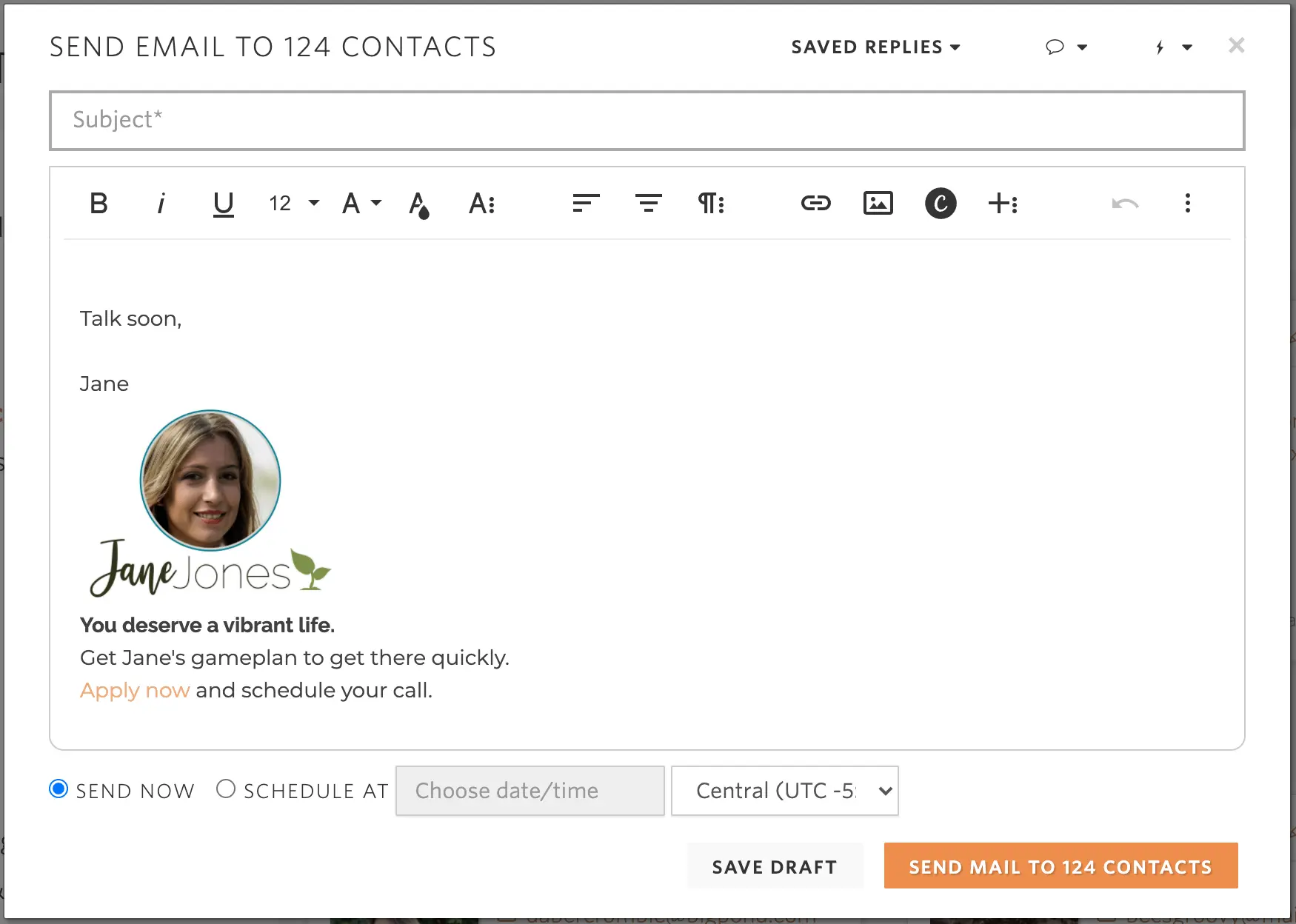

Track Client Progress
Keep track of your clients' progress over time. Optionally share the progress with your client and even let them edit it to save you time as you track key metrics.
Replaces



“I used to have separate programs for my texting, emails, events, client progress tracker, CRM, and Zooms, but with AttractWell I am able to have them all in ONE space! They just flow so well together and it makes working my business, as a busy mom of three so much simpler! I am so grateful for this resource. I wish I would have started using it years ago!”
Amanda D - Wellness & Life Coach
See Who's Engaging
Know who's opening and clicking your emails so you can follow up at the right time. See who's clicking links in your text messages with a built-in URL shortener that's branded to you. Get notified by email or text of anyone who registers on your site with a landing page, and know when they visit your site again. See progress that your clients or prospects make through your online classes and know when they last visited your member area. Summary contact activity is sent to you in your daily activity email and your contacts dashboard.
Replaces


“I am reaching out at the right time now that I can see who is opening and clicking emails & texts, which has helped me make more sales.”
Joni M - USA

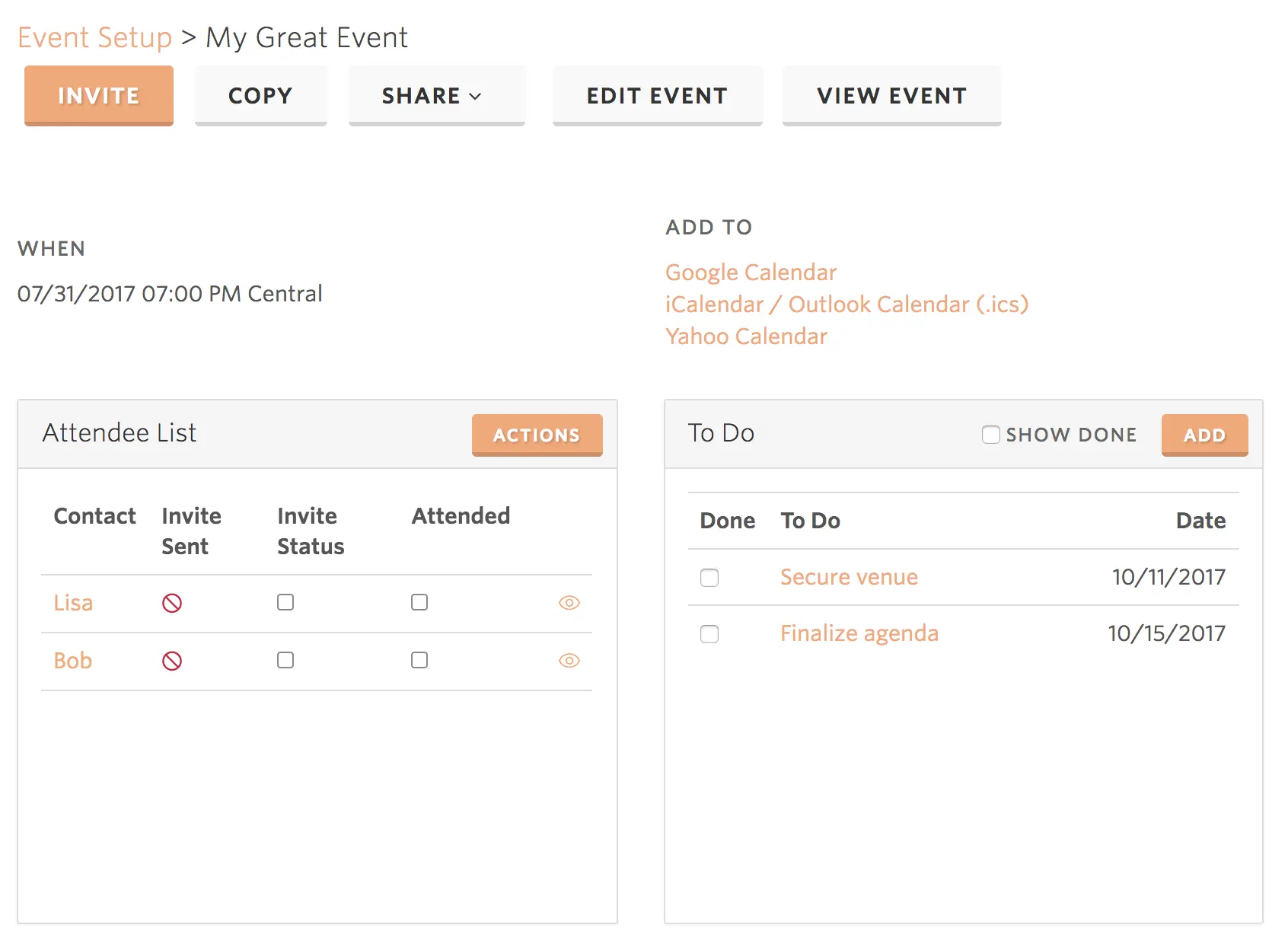
Simplify Event Planning
Do you hold in-person or online events? If so, handle your events with ease using your events RSVP system. Publish your events on your website, invite people right from AttractWell, let them register for your event online, and send emails and texts to people based on whether they have said yes, no, maybe, or haven't replied, and more. Manage to-do items for events or use a follow-up plan with an event to automate repetition if you frequently hold the same type of event.
Replaces



“I used to have really low attendance at my events due to lack of promotion. Now I don't even have to think about promotion and follow up to events because the system does it automatically for me. I am getting more clients while spending the same amount of time as before.”
Jill P - Life Coach
E-Commerce
Sell products and services with a traditional e-commerce experience where shoppers can select products, change quantities, add them to a cart, and check out. This feature allows you to create a storefront with collections, products, coupons, shipping, tax calculation, and more.
Replaces



“I'm so impressed with not only the product you provide but the amount and level of teaching and support is incredible. I'm really excited!”
Allison M - USA


Automate & Eliminate Repetition
Do you commonly take the same steps for each new client or hot prospect? Set up follow-up plans (which are pre-packaged lists of to-do items), schedule to-do items in advance, and get reminded on your AttractWell dashboard and with an email when the time is right. Follow-up plans can be applied after people complete key steps, letting you make the most out of your and their valuable time.
Works with 
Need even more robust automations? Use Zapier to connect AttractWell to thousands of other apps, allowing you to send contacts to other apps, trigger actions in other apps when people complete key steps in AttractWell, send campaigns, add tags, and more based on what happens in other apps, and more.
Replaces



“Before AttractWell, my life was a sea of sticky notes, notebooks, and forgotten to-do lists, a.k.a. a non-productive mess! Now I'm organized and don't forget anything.”
Peggy W - Health Coach
Coaching Business Training & Feedback

“I need to say that AttractWell is amazing. I've been with other platforms in the past, like Shopify and Square, great platforms but you guys far exceed them in my point of view. Thank you!”
Jeanette P - Life Coach
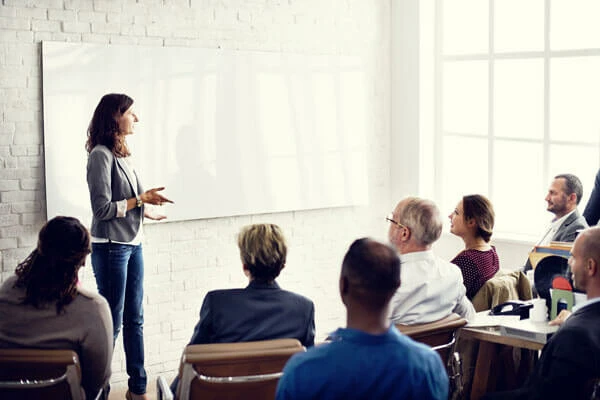
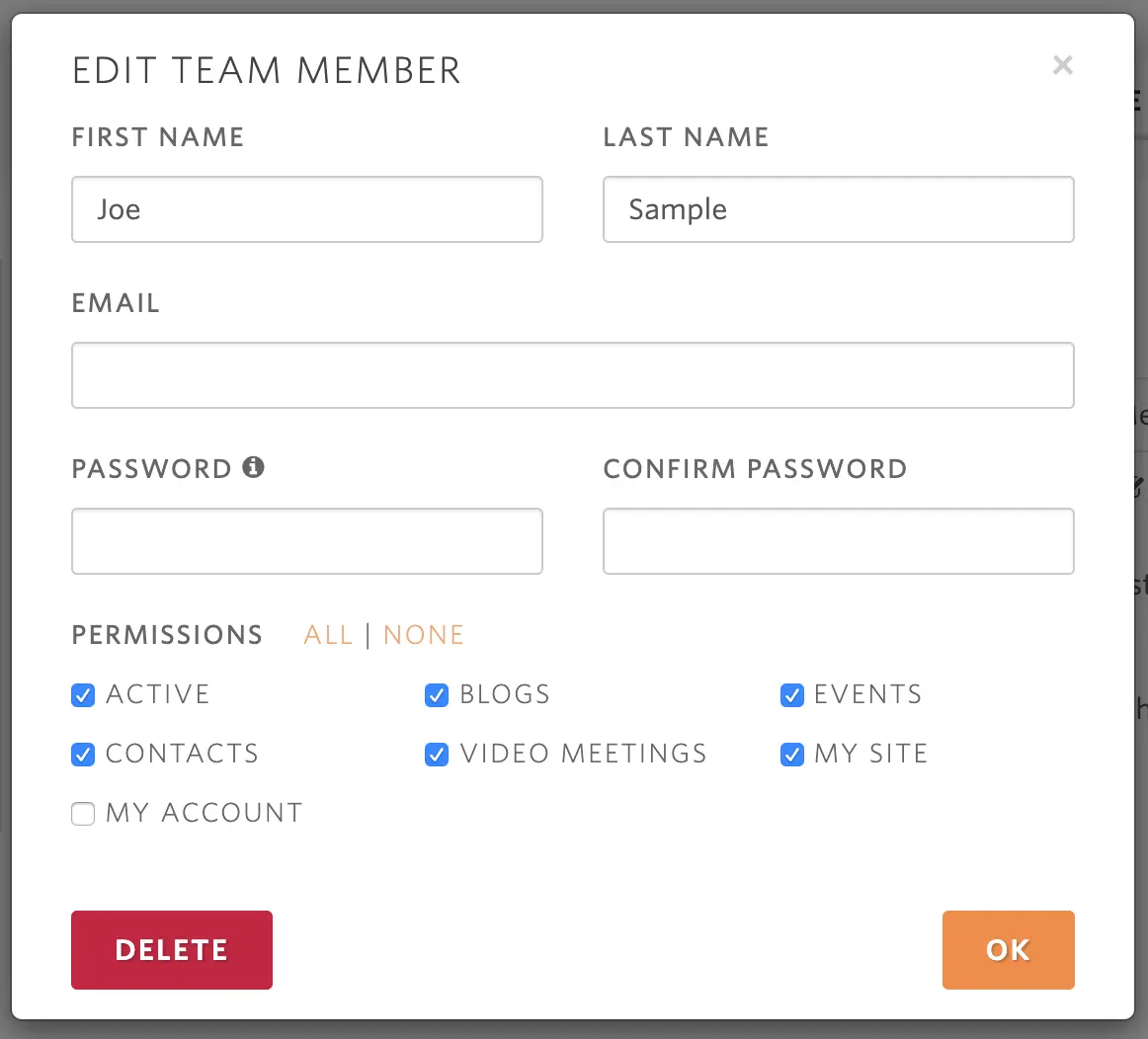
Be Supported By Your Team
Set up separate accounts for your team members, or accounts for virtual assistants, guest bloggers, etc. Control what parts of your account each team member can see and change or remove access any time.

“I used to spend a lot of time gathering my email list and writing regular emails. With AttractWell, I can now safely assign it to my virtual assistant. I love that I can control what parts of my system my VA can access, too.”
Marinés H - Business Coach
Be Productive On-The-Go
Be productive while you're away from a computer with the AttractWell phone and tablet app for both Apple and Android devices.
When you use it, you can manage your AttractWell system on-the-go to perform tasks like sending bulk emails, working your to-do list, setting up your website, and more. You can also interact in your member area.
When your contacts use it, they can interact in the vaults in your member area. This allows them to comment on discussions or make posts, watch your training, and access your resource pages that you've given them permission to see. It's like having your own app that combines the best of e-learning and social media, just for you. And it's super simple for both you and your contacts to use.

“AttractWell replaces 6 of my paid subscriptions and gives me an amazingly beautiful website. My Dashboard makes it easy to follow up with people, and I love, love, love the app. All my business needs in one place - Zoom, follow ups, emails, contacts, events, website, blog, and more. I love AttractWell!”
Robin C - Mindset Coach
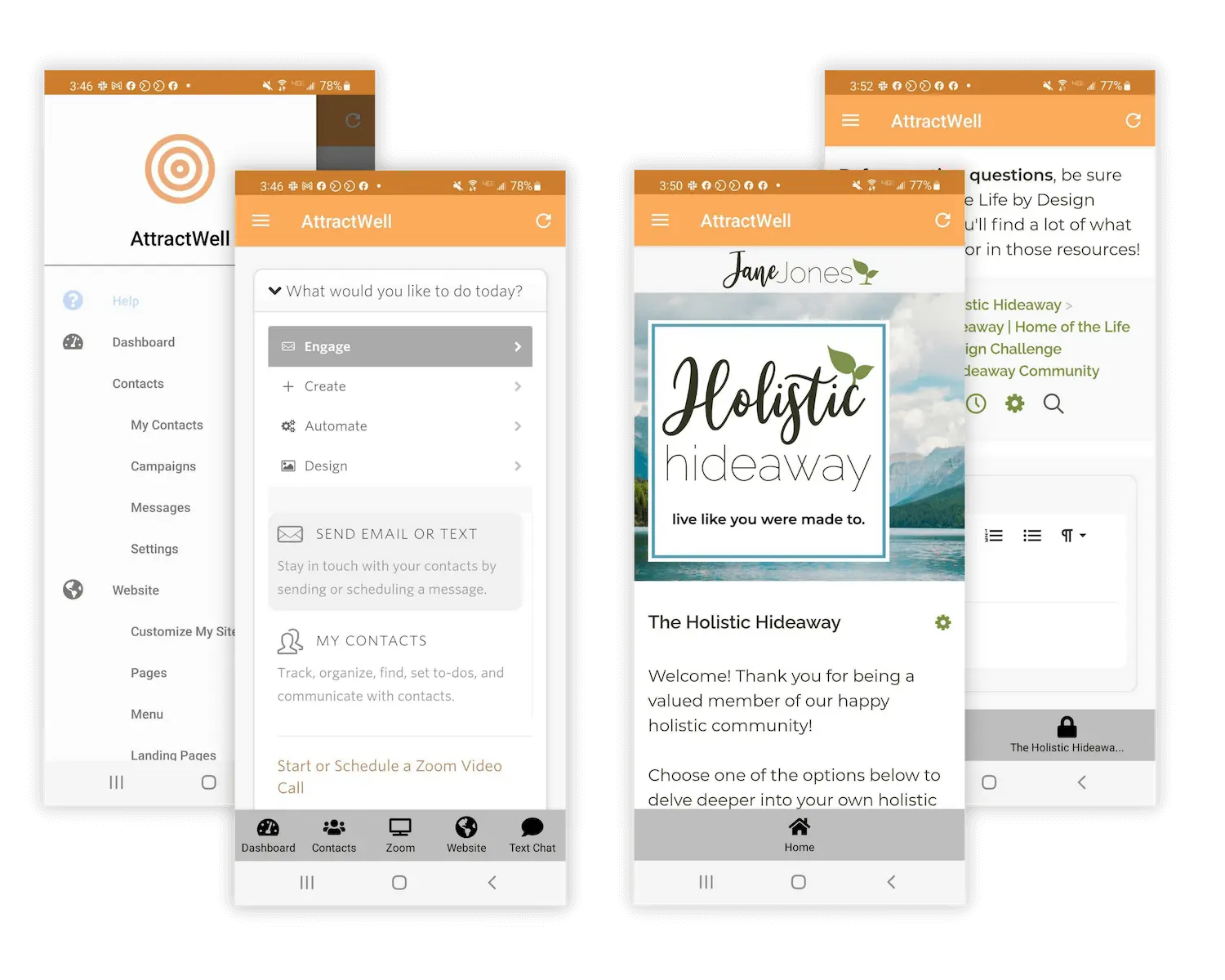

Give Your Clients A Head Start
If you have a program that helps people grow their business online and your clients need a product like AttractWell, our resource bundle feature can give your students a head start on their own tech. Provide digital assets like web pages, campaigns, automations, classes, blog posts, and more for them to use in their own AttractWell account. A few clicks and their online business is off to a head start.

“I created a course for my clients to help them quiet the overwhelm of tech and systems and I was able to give them all the tools I made in AttractWell as a part of the course. That is such a huge value-add for my clients!”
Lauren H - USA
Don't Go It Alone

“I cannot believe it's been a year! I could not have done this much in a year on my own without the help of the AttractWell team. Thank you!”
Renée A - Reiki Healer


BONUS: Free Courses

“ I am so thankful for AttractWell! It has changed the way I do life and my biz! I had a CRM, a blog site, an online scheduler, a meeting app and an app for coaching notes. AttractWell has replaced them all. Many of them were not even as robust as what AttractWell hosts. Several had very clunky apps, if apps at all. AttractWell's Office Hours allow me to learn at a pace that fits my speed of life. The courses and challenges are presented in an easy to follow and understand format. My life has much less stress now, and I find that work is more fun and less hurried!”
Sheri Geyer - Relationship Coach

Need Leads?

Double your leads and high ticket clients without spending a fortune on complicated tech using this one-page strategy + training.